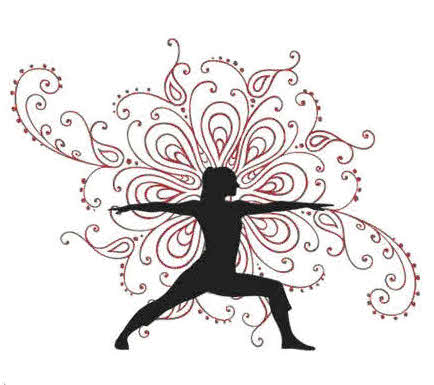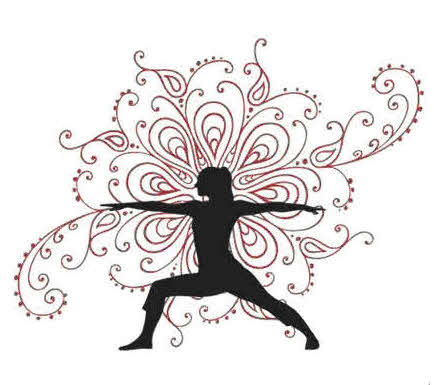
Neck Warm Ups
Necks get a rough time. We rarely think about how important our necks are. The interesting thing is that many of the yoga postures do work the neck in a very positive way.
As we get older, it is very important to keep a strong, flexible neck.
This series of neck warm ups gives a complete work out for the neck in a very gentle manner.
Always listen to your body. It is fine if you only make small movements to begin with and just hold them. Do not feel you have to do a neck roll because everybody else in the class is. It is your neck. Listen to what it is telling you.
1. Before you start on your neck exercises, shrug your shoulders up and down a bit to release any tension at the base of your neck.
2. Neck Roll
It's a lovely feeling to shut your eyes and turn your attention to the neck in these exercises.
a) Side to side.
Simply turn your head slowly to the right and hold the best position you can while you take two deep breaths.
Then turn your head slowly to the left and hold the best position you can. Take two deep breaths.
If you are stiff in the neck, then simply practise doing this and do not move on to the half roll.
b) Half roll
Gently turn your head to the right and then let your head dip forward and move your head to the left, making a half circular movement. Pause at the left for two breaths and then return to the right, dipping the head as you go. Pause at the right for two breaths.
Repeat several times.
Again listen to what your neck is telling you. This may be the exercise you need to stick on for a while.
If it felt easy-peasey move on to the full roll
c) Full roll
Let your head draw out a half circle as it moves from the right to the left, dipping the head forwards.
When you reach the left side, let your head tip backwards but only a little and continue rotating it towards the right side.
(Sometimes you see a person letting the head tip as far backwards as they move it forwards but for many people that could cause problems. Certainly as we get older, tipping our head backwards a long way is not advisable. So think of the shape your head makes as being almost D shaped, the circle as you let your head bend forward but almost straight as you let your head tip just a tiny bit backwards)
There is no magic number as to how many repeats you should do. I repeat until I can feel that my neck is giving me its full range of motion, sometimes that takes 5 repeats, other times more repeats, even up to 10 repeats.
Remember to rotate your neck the other way when you have finished.
3. Byron's pose

This stretches the SCM muscle the sternocleidomastoid muscle. There is a famous sketch of the poet Lord Byron with his head turned to emphasise his SCM muscle. Was he a poser? Or was it chance? Who knows?
i) Turn your head to the right and then look over your right shoulder. Hold for two breaths.
ii) Turn your head to the left and look over your left shoulder. Hold for two breaths.
I repeat this twice but if you can feel you neck is really stiff when you are doing this, by all means repeat some more and also you can choose to hold the best position you can move your neck into for longer. Listen to what your neck is telling you.
4. The Scalene Stretch

i) Turn your head to the right and then tip your head so that the top of your head points down towards the left nipple. Hold for a count of two breaths
ii) Turn your head to the left and tip your head so that the top of your head points down towards the right nipple. Hold for a count of two breaths.
Repeat as many times as you feel necessary. I usually do this twice. If however you feel stiffness in this muscle repeat a few more times. Remember to listen to your neck, effort is good, pain is not. Do not push your neck into a painful position.
5 Side to Side

i) Try to take your right ear to your right shoulder.
ii) Come back to a vertical head position
iii) Try to take your left ear to your left shoulder
iv) Come back to a vertical head position
Repeat i) to iv)
There are two ways you can practise this exercise
a) Slowly. This is the only way people with osteoporosis and neck problems should do this exercise.When you reach your furtherst point simply relax and hold that position for two breaths before returning your head to the vertical position.
b) Gradually increasing the speed as you move your head from one side to the other. Remember yoga is not a competition and there are no prizes for going faster than anybody else in the class. Just go at the speed that feels good for you.
It is good to shut the eyes in this posture and to imagine that the head is pivoting about the middle eye which the yogis believe is in the middle of the forehead. It is the location of the Ajna Chakra and also is the point where the two nadis Ida and Pingala cross. Nadis are considered to be subtle paths of energy within the body.
6. Catching flies
In a class you have to do this with your eyes shut. Watching anybody else will give you the giggles. However this is one of the few exercise that also tones up the muscles that hold your chest and for ladies the breasts upwards. So it not only benefits the neck but it reaches the parts other exercises don't.
It is very simple.
Tip your head back a bit and imagine you are catching flies, opening and shutting your jaws.
Aim to build this up to catching 20 flies and feel how your double chin is being whittled away!
This is actually a very important exercise because as we get older our necks get weaker and tend to allow our heads to fall forwards. This exercise strengthen the muscles that hold the head up.
7. Pressing the tongue against the inside of the upper teeth
This is a really good exercise for anybody whose head is starting to collapse forwards and is very good to practise if you have osteoporosis.
Press your tongue against the inside of the upper teeth and hold the pressure for two breaths. You will feel muscles working in the front of your neck, the deep neck flexors.
As you get better at this, you may chose to repeat several times or to hold for longer. The choice is yours.
8. Five way exercise
i) Turn your head to the right, bring it back a little and then take it back to the right.
ii) Turn your head to the left, bring it back a little and then take it back to the left.
iii) Take your head to a right diagonal making a 45 degrees tip slightly backwards and to the right, bring it back a little and then take it back to that 45 degree position
iv) Take your head to a left diagonal making a 45 degrees tip slightly backwards and to the left, bring it back a little and then take it back to that 45 degree position
v) Tip your head backwards a little and then bring it forwards a little and take it back again
Repeat i) to v)
Warning this can be done with almost a bounce to the movements by those who are young and flexible but if you have osteoporosis or neck problems this should be done very slowly with NO bounce and if it doesn't feel good at any stage, stop.
Once upon a time when I was a student in Japan, I knew a very beautiful lady who always looked immaculate. I thought she was in her early thirties and was stunned to discover she was nearly fifty. She came for a meal with my Japanese family and at the end of the evening when she had gone, we asked Oba-san-ma the mother of the Japanese house how old she thought the lady was. Nearly fifty came the reply. We were shocked. How could she know so accurately?
"I looked at her neck" Oba-san-ma said.
So if you are young and beautiful and reading this, please make a point of doing your neck exercises everyday and then maybe your neck will not give your age away when you reach fifty!

